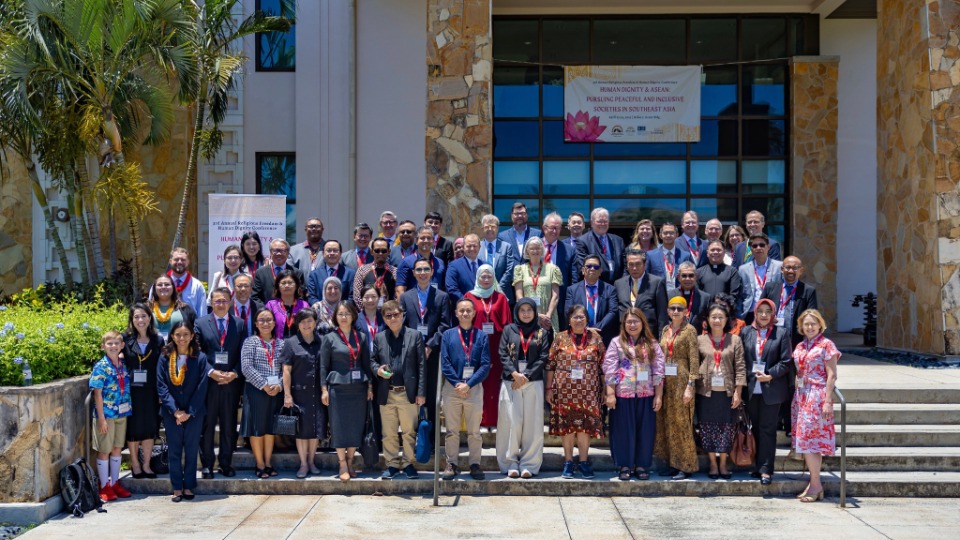(This Content Is for Non-Muslim Use only)
Some 170 people of various faiths across Southeast Asia gathered on the picturesque campus of Brigham Young University–Hawaii from April 22 through April 25, 2025, to discuss the pursuit of peaceful and inclusive societies.
The conference was organized by the Religious Freedom and Human Dignity Initiative at BYU–Hawaii, alongside collaborators at BYU’s International Center for Law and Religion Studies, the Religious Freedom Institute, and the Leimena Institute of Indonesia.
The conference brought together religious leaders and scholars representing a diverse range of faiths, including the Anglican Church, the Buddhist Missionary Society, the Catholic Church, the Institute of Islamic Understanding and The Church of Jesus Christ of Latter-day Saints. They shared insights on religious freedom and human dignity in Southeast Asia and offered practical suggestions for advancing these principles in their home countries.
- 25_04_22_RFHD_EG_44.JPG
- 25_04_22_RFHD_EG_48.JPG
- 25_04_22_RFHD_EG_59.JPG
- 25_04_22_RFHD_EG_67.JPG
- 250423_RFHD_Conference_Panels_KT_26.jpg
- 04_23_25_Conference_Dinner_DF.JPG
- 04_23_25_Conference_Panels_DF_29.JPG
- 04_23_25_Conference_Panels_DF_26.JPG
- 250422_RFHD_Temple_Tour_KT_35.jpg
| Temple Square is always beautiful in the springtime. Gardeners work to prepare the ground for General Conference. © 2012 Intellectual Reserve, Inc. All rights reserved. | 1 / 2 |
“Southeast Asia is one of the most religiously diverse regions on the planet, where many global religions and indigenous communities live side by side in vibrant communities,” said Elder Michael B. Strong of the Church’s Philippines Area Presidency. “As leaders of our countries and communities, we must strive to build pluralistic societies where peace, unity, and harmony thrive.”
Elder Strong acknowledged BYU–Hawaii’s focus on promoting peace, intercultural understanding, and the core values of appreciation, tolerance, and esteem—principles he said “unite all peoples” in ways no other university can.
Continuing the theme of leadership and service, Elder Nithya Kumar Sunderraj of India, a member of the Church of Jesus Christ’s Fourth Quorum of the Seventy, also attended the conference and met with BYU–Hawaii students. He taught students how to become Christlike leaders, serve their communities and support religious freedom and human dignity in their home countries.
Beyond the formal sessions, delegates also experienced some of the unique aspects of the BYU–Hawaii campus and the local community. For example, delegates toured the Laie Hawaii Temple grounds. This was the first house of the Lord built outside the continental United States. Student representatives guided the tour, offering insights into the temple’s sacred purpose and historical significance. Delegates asked questions, engaged in thoughtful conversations, and formed connections that bridged religious and cultural differences.

A unique and culturally inspired feature of the conference was the “talanoa” gatherings, discussion sessions where students and community members engaged in meaningful dialogue with delegates. Four talanoa sessions took place, offering students the chance to connect with leaders from India, Indonesia, Laos, Malaysia, Myanmar, the Philippines, Singapore, Thailand and Vietnam. These informal, face-to-face conversations allowed students and delegates to discuss pressing issues, future goals, and interfaith questions. Delegates even asked students about their own faith, leading to mutual understanding and strengthened connections. Many described the talanoa sessions as a highlight of the conference.
With a large number of Southeast Asian students attending BYU–Hawaii, many volunteered their time and talents to support the conference. They provided a welcoming presence that helped fuel connections, even far from home, and facilitated meaningful discussions on challenges that their home countries face. These students also had the opportunity to present research projects on religious freedom in Southeast Asia. They helped coordinate sessions, drive delegates, write summaries, and guide participants throughout the event.
The spirit of aloha was present throughout the conference, as students, delegates, and leaders from diverse backgrounds came together with mutual respect and a shared commitment to building a more peaceful and inclusive Southeast Asia.